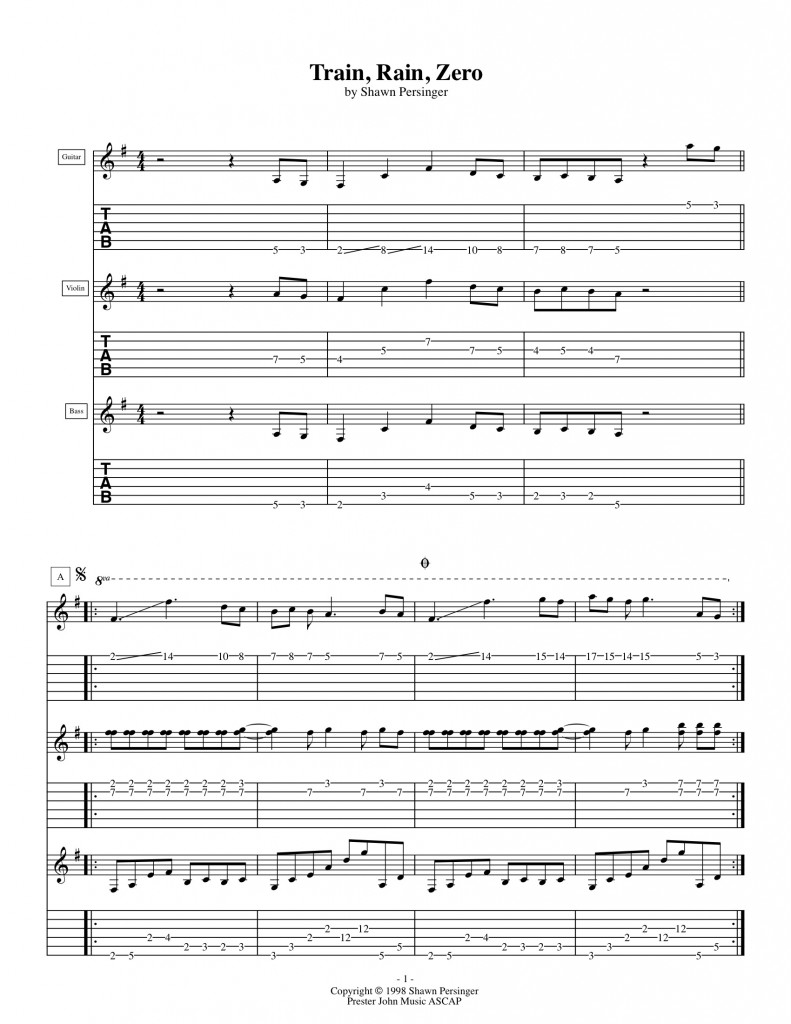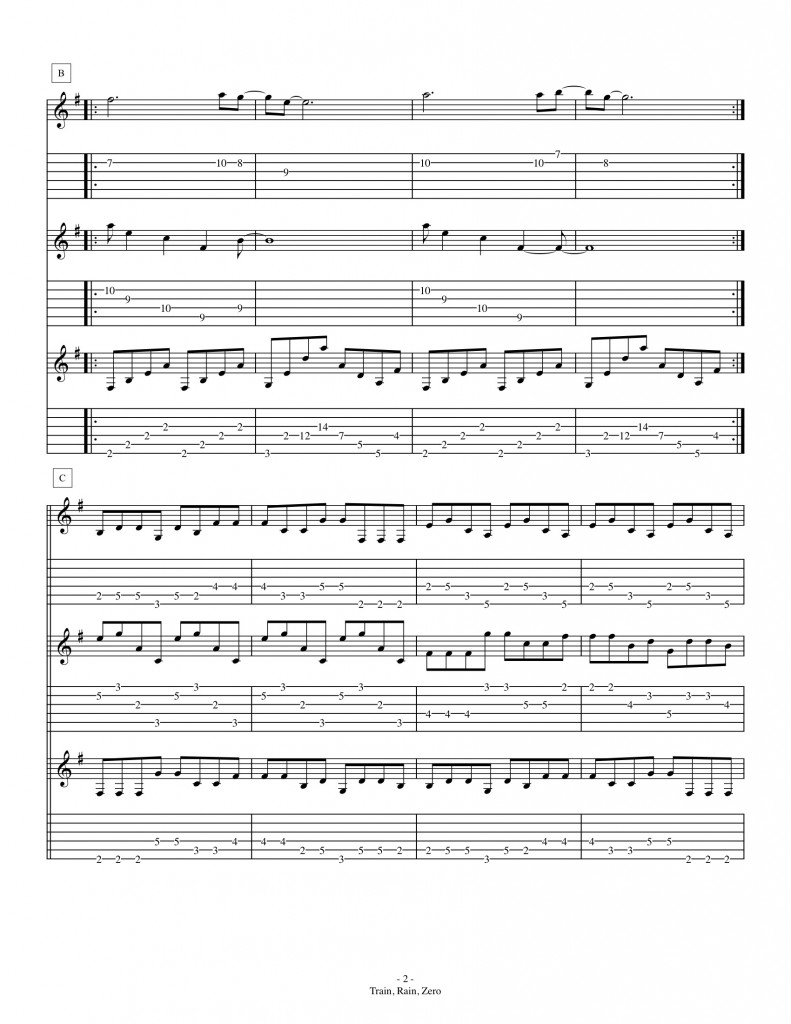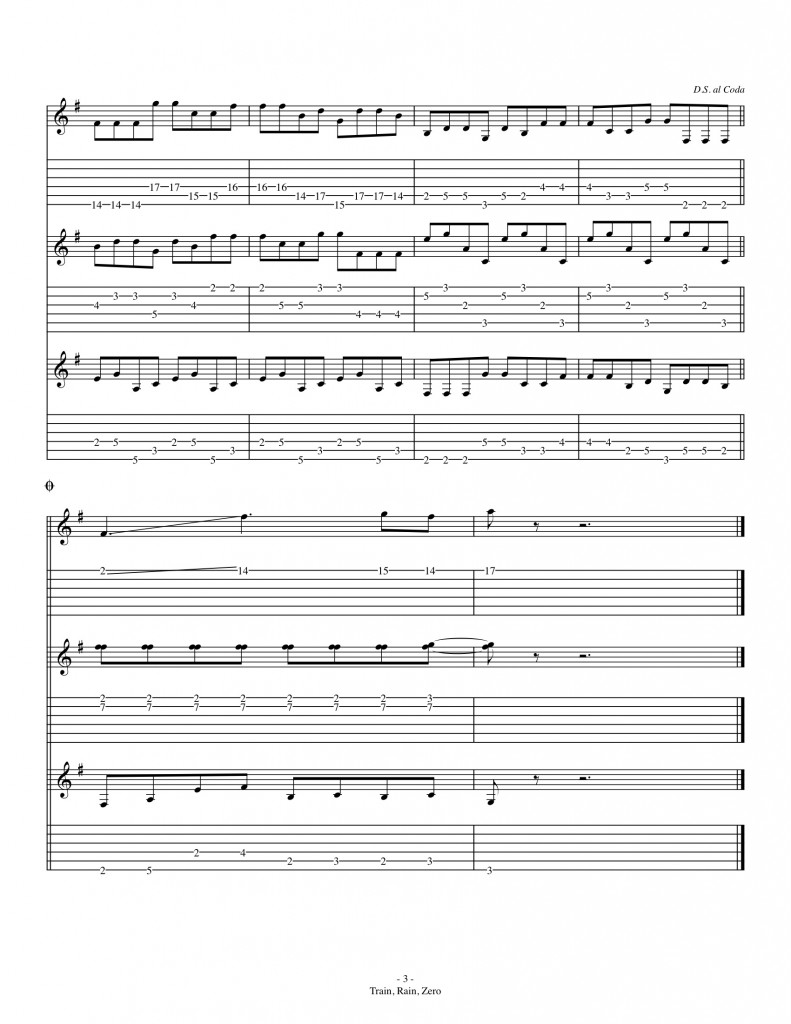No. 1: The Locrian Mode
This is a piece I wrote for my band Boud Deun for our 1998 recording The Stolen Bicycle. The theory explanation for this lesson is below the sheet music (click on the sheet music to download for free).
Weird Guitar Lesson No. 1: The Locrian Mode
This lesson is about the Locrian mode and it’s use in the song “Train, Rain, Zero.”
Without going into too much detail about what modes are and how they work (that is another lesson – though below you will find a basic mode primer) here is the basic idea behind the Locrian mode, and/or the Locrian sound.
The Locrian mode is the seventh mode of the major scale. That mean all the notes in the Locrian mode are the same as the notes in the major scale (also known as the Ionian mode), with the emphasis put on the 7th scale degree.
In this lesson, the song we’ll study, “Train, Rain, Zero,” is in the key of F# Locrian, which means it contains all the notes in the G major scale, but the emphasis, harmonically (most important) and melodically is on the F#. There is also considerable emphasis being put on the F#’s relationship with the note C (F# and C have a b5 relationship, also known as a tritone and diminished 5th) and the note G (F# and G have a b2 relationship, also known as minor second). These two relationships (b5 and b2) are very dissonant, thus many people consider them “weird” and find them difficult to use.
Train, Rain, Zero
“Train, Rain, Zero” has three main sections and an introduction. Below I’ve highlighted the significant Locrian features of the song.
Introduction: The introduction is a variation on the A melody. It emphasizes the F# and it’s relationship with the C (the tritone relationship). The band plays this phrase in unison. The guitar plays on one string, emphasizing the slide, and physically exaggerating the intervallic distance.
A Section: The A melody is played on one string. It emphasizes the F# and, to a small degree, the relationship with the G (the minor second).
The A harmony is most important regarding the Locrian sound. The guitar plays unison F#s, then slides the 1st string F# up to G, emphasizing the b2 relationship. The bass emphasizes F# throughout.
B Section: The B melody continues to emphasize the F#. The first time the guitar plays the B melody it is performed using artificial harmonics.
The B harmony is most important regarding the Locrian sound. The chord played is an F#m7(b5). The bass emphasizes F# throughout.
C Section: This section is made of up three, two-measure riffs, emphasizing the F# throughout. Each instrument is playing the exact same three riffs but beginning on different ones. For example the guitar is playing the riffs in this order: 1, 2, 3, and 1. The violin plays in this order: 2, 3, 1, and 2. And the bass plays in this order: 3, 1, 2, and 3. Three items to point out: (1) The violin plays it’s notes in different octaves. (2) The guitar’s riff 2 is slightly different from the violin and bass. (3) Riff 3 is riff 1 played backwards.
That’s it (except the drum parts, which are also very interesting and melodic in their own way: note the F# timpani in the B section). Thanks for reading.
– Shawn Persinger is Prester John
A Very Basic Mode Primer
Modes are just sounds. Many people think and teach they that are primarily scales, but really modes are a sound. And the most important aspect of the sound is the harmony or chord progression.
For instance: The major scale is, known as the Ionian mode, is a “happy” sound. The natural minor scale, known as the Aeolian mode, is a “sad” sound. For many musicians that is where their knowledge and understanding of modes ends. But there are many other modes.
I’m going focus on the major scale’s seven modes, just briefly. Beginning again, with:
The Ionian mode, the happy sound. Pop music.
The Dorian mode, the “jazzy” sound, also the “Carlos Santana” sound *. 70s Funk/Fusion.
The Phrygian mode, the Spanish/Flamenco sound. Also Middle Eastern.
The Lydian mode, a new age sound.
The Mixolydian mode, the jam band, Grateful Dead sound. Frank Zappa also used this mode a lot.
The Aeolian mode, the sad sound. Most sad songs, also most Metal songs.
The Locrian mode, the weird, dissonant sound. (See below for a few points of reference).
The words I am using to describe the modes, “happy,” “jazzy,” “new age,” etc. are most certainly subjective, but after years of teaching I’ve found these are the most common descriptors (or bands) most people associate with each individual mode.
The very few examples of the use of the Locrian mode I know of can be found in Debussy’s Jeux, a few passages in Rachmaninov’s Prelude in B minor, Op. 31, No. 10, Hindemith’s Ludus Tonalis and Symphonic Metamorphosis of Themes by Carl Maria von Weber, and Sibelius’s Symphony No. 4 in A minor, Op. 63. Also John Kirkpatrick’s Dust to Dust and many heavy metal riffs.
* See Frank Zappa’s “The Carlos Santana Secret Chord Progression.”
The End


